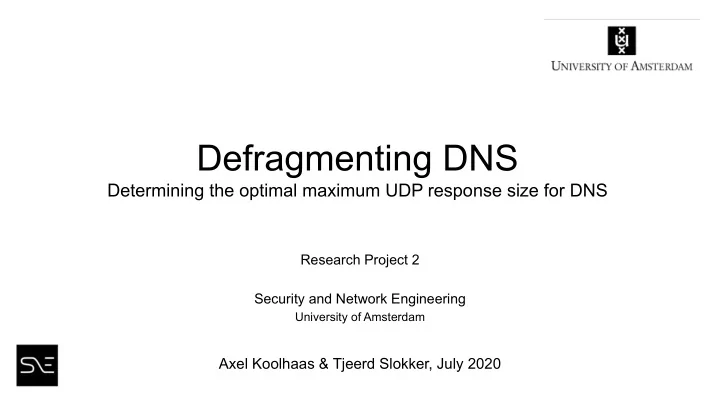

Defragmenting DNS Determining the optimal maximum UDP response size for DNS Research Project 2 Security and Network Engineering University of Amsterdam Axel Koolhaas & Tjeerd Slokker, July 2020
Background ● The Domain Name System (DNS) translates host names into IP addresses ● DNS works with Resource Records A, AAAA, DNAME, etc... Source: Wikipedia.org 2
Background ● EDNS(0) are extension mechanisms for DNS, and the current default ○ EDNS has UDP Message Size, communicating response size capability ● The Internet is a network of networks ○ Not every network has the same Maximum Transmission Unit (MTU) 3
Background ● Path MTU Discovery (PMTUD) discovers Path MTU between two nodes ○ PMTUD is flawed, due to conservativity and failing ICMP messages ● Fragmentation occurs when a packet exceeds the PMTU ○ IP fragmentation introduces fragility to DNS ○ ICMP messages cause problems for DNS servers since they are stateless 4
Recap ● PMTUD is unreliable ● DNS is connectionless which causes problems with fragmentation of DNS packets We aim to suggest an optimal maximum EDNS message size for DNS ❖ 5
Research Questions ● What is the optimal EDNS message size to avoid IP fragmentation? ○ Is there a difference between IPv4 and IPv6 regarding PMTU sizes? ○ Which EDNS message size is best in terms of support for DNS stub resolvers? ○ Which EDNS message size is best in terms of support for DNS open resolvers? 6
Related Work How many problems does fragmentation cause? ● Weaver, et al. showed that 9% of DNS resolvers don’t receive fragmented UDP datagrams [1] ● Van Den Broek, et al. expanded on this, showing that as much as 10.5% of all resolvers suffer from fragmentation-related connectivity issues [2] 7
Related Work How can you measure the PMTU? ● Toorop used custom name servers experiment with different EDNS message sizes [3] ○ Different sub-domains produce different sized responses ● DNS-OARC used a custom DNS server and chained CNAME responses [4] ○ Server sends multiple replies, where each reply decreases in size. ❖ Both use custom name servers, decreasing reproducibility 8
Related Work How can fragmentation in DNS be prevented? ● Fujiwara & Vixie wrote a RFC draft on fragmentation avoidance in DNS [5] ○ A suggestion is made on a possible maximum EDNS message size 9
Related Work How can fragmentation in DNS be prevented? ● Fujiwara & Vixie wrote a RFC draft on fragmentation avoidance in DNS [5] ○ A suggestion is made on a possible maximum DNS/UDP payload size Topical subject! ❖ 10
Methodology 11
Platform to perform measurements with Methodology 12
Four separate Atlas measurements Methodology 13
Methodology The paths we measure 14
Our DNS server Methodology 15
Solution to universal query Methodology 16
We aggregate our results from the Atlas API and dnstap Methodology logs 17
Results IPv4 Stub Resolver Note: this is the EDNS message size, so MTU minus IP and UDP headers Stub Resolver IPv4 1452 IPv6 18
Results IPv6 Stub Resolver Stub Resolver IPv4 1452 IPv6 1364 19
Results open IPv4 Resolver Stub Resolver IPv4 1452 1232 IPv6 1364 20
Results open IPv6 Resolver Stub Resolver IPv4 1452 1232 IPv6 1364 1232 21
Discussion - Results ● MTUs 1500 & 1492 stand out ● IPv6 Stub ● IPv4/6 Resolvers 22
Results IPv6 Stub Resolver Stub Resolver IPv4 1452 IPv6 1364 23
Discussion - Results ● MTUs 1500 & 1492 ● IPv6 Stub ● IPv4/6 Resolvers 24
Results open IPv6 Resolver Stub Resolver IPv4 1452 1232 IPv6 1364 1232 25
Discussion - Limitations ● MTU support Digital Ocean ● Dynamic paths ● Failing probes ● RIPE Atlas bias 26
Conclusion ● Created publicly available reproducible environment [6] ● EDNS(0) message sizes Stub Resolver IPv4 1452 1232 IPv6 1364 1232 27
Conclusion ● Created publicly available reproducible environment [6] ● EDNS(0) message sizes Stub Resolver IPv4 1452 1232 IPv6 1232 1232 28
Conclusion ● Created publicly available reproducible environment [6] ● EDNS(0) message sizes Stub Resolver IPv4 1452 1452 IPv6 1364 1412 29
Future Work ● Spread of probes within ASs ● Failing probes ● Continuation 30
There is no single “magical” EDNS(0) message size for all DNS resolver implementations. Special thanks to Willem Toorop from NLnet Labs for all his help. 31
References [1] - Weaver, N., Kreibich, C., Nechaev, B., & Paxson, V. (2011, April). Implications of Netalyzr’s DNS measurements. In Proceedings of the First Workshop on Securing and Trusting Internet Names (SATIN), Teddington, United Kingdom . [2] - Van Den Broek, G., van Rijswijk-Deij, R., Sperotto, A., & Pras, A. (2014). DNSSEC meets real world: dealing with unreachability caused by fragmentation. IEEE communications magazine , 52 (4), 154-160. [3] - Toroop. (2013) https://medium.com/nlnetlabs/using-pmtud-for-a-higher-dns-responsiveness-60e129917665 [4] - OARC. https://www.dns-oarc.net/oarc/services/replysizetest [5] - Fujiwara & Vixie. (2020) Fragmentation Avoidance in DNS [6] - https://github.com/shoaloak/defragDNS 32
Recommend
More recommend